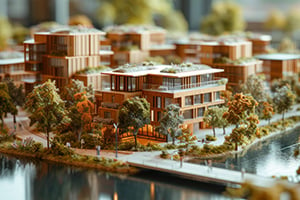By Devin Takekawa
Engineering Analyst
Sustainable Investment Group (SIG)
 Did you know that approximately 40% of energy leakage within a building is often traced back to its envelope? You may be thinking, how is that even possible? Well frankly, the envelope of a building is essentially the exterior structure, which consists of windows, exterior doors, the roof, exterior walls, and any subflooring. All of these components make up the envelope and if they are not properly designed and integrated, your building could be losing amounts of wasted energy. To add more, your building could also be missing out on LEED credits that would add points to your scorecard.
Did you know that approximately 40% of energy leakage within a building is often traced back to its envelope? You may be thinking, how is that even possible? Well frankly, the envelope of a building is essentially the exterior structure, which consists of windows, exterior doors, the roof, exterior walls, and any subflooring. All of these components make up the envelope and if they are not properly designed and integrated, your building could be losing amounts of wasted energy. To add more, your building could also be missing out on LEED credits that would add points to your scorecard.
One of the first and maybe the most beneficial improvement towards your envelope is applying film or tint to the windows of your building. Adding in window film or tint will be able to reflect back more UV-rays which will lead to less glare, lower cooling demands, and less heat entering into the workspace. Being able to reflect these UV-rays will also provide better thermal comfort towards your occupants. Also, HVAC systems will not have to work as hard to cool or heat the occupied spaces because the window films reduce the transmission of outside temperatures into the building.
 The next step you could take towards improving your building’s envelope would be to retrofit the exterior doors. The ideal retrofit would be to install revolving doors because they are able to stop more free flow of air coming into the building in comparison to swinging or sliding doors. An easier approach towards retrofitting would be to replace the weatherstripping or door sweep of the door frames. By changing these to some sort of rubber material like silicone or neoprene, the results could lead to less energy leaks and help your building retain conditioned air.
The next step you could take towards improving your building’s envelope would be to retrofit the exterior doors. The ideal retrofit would be to install revolving doors because they are able to stop more free flow of air coming into the building in comparison to swinging or sliding doors. An easier approach towards retrofitting would be to replace the weatherstripping or door sweep of the door frames. By changing these to some sort of rubber material like silicone or neoprene, the results could lead to less energy leaks and help your building retain conditioned air.
 Another innovative way that a building’s envelope could improve is by retrofitting your roof into a cooler or greener one. By doing so, it could significantly reduce the heat island affect by lowering temperatures on the roof and the air surrounding the building. According to the EPA, green roofs can be 30 to 40 degrees cooler than traditional and conventional roofs [1]. Green roofs often consist of multiple layers of membranes and barriers which allow for vegetative life on the surface. Cool roofs consist of highly reflective surfaces that are made out of emissive materials that allow the building to remain cool during peak temperatures. Both styles of roofing are beneficial and could be retrofitted onto many types of existing buildings.
Another innovative way that a building’s envelope could improve is by retrofitting your roof into a cooler or greener one. By doing so, it could significantly reduce the heat island affect by lowering temperatures on the roof and the air surrounding the building. According to the EPA, green roofs can be 30 to 40 degrees cooler than traditional and conventional roofs [1]. Green roofs often consist of multiple layers of membranes and barriers which allow for vegetative life on the surface. Cool roofs consist of highly reflective surfaces that are made out of emissive materials that allow the building to remain cool during peak temperatures. Both styles of roofing are beneficial and could be retrofitted onto many types of existing buildings.
By applying any of these renovations, your building would see new energy savings, an increase in occupant comfort, and modern aesthetic looks! While doing so, you could also be chipping away at the LEED credit: Energy and Atmosphere 1.5, which is to optimize energy performance. After doing one or all of these renovations, your building could earn this credit towards your scorecard if you demonstrate that your building has a 15% reduction in heat loss of the newly proposed building envelope. Another LEED credit that you could be working towards is for Sustainable Sites- Heat Island Reduction. This credit can usually be achieved by the installation of a green or cool roof. Besides just doing these renovations for LEED, keep in mind that you are “investing” back into the environment and taking the right steps to reduce the building’s carbon footprint.
If you or the manager of your building have any questions about LEED or the application process itself, feel free to contact us, SIG, as we are green building consultants that offer training, consulting, and engineering. Reach out to Asa at asa@sigearth.com.
Credit
[1] https://www.epa.gov/heat-islands/using-green-roofs-reduce-heat-islands
© 2020 Sustainable Investment Group (SIG). All rights reserved.



